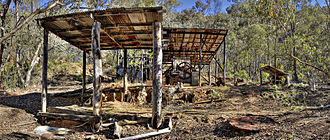AY Honors/Gold Prospecting/Answer Key
The Victorian gold rush was a period in the history of Victoria in Australia between approximately 1851 and the late 1860s.
During this era, Victoria dominated the world's gold output. Ballarat for a while was the richest place on earth in terms of gold production.&
Gold discoveries in Beechworth, Ballarat and Bendigo staggered the world and sparked gold rushes similar to those of California in 1849. & At its peak some two tonnes of gold per week flowed into the Treasury Building in Melbourne.
The gold era hurled Victoria from a sheep grazing economy based around wealthy squatters, into an emerging industrial base and small (yeoman) farming community. The social impact of gold was that Victoria's population boomed and the lack of available land for small farming generated massive social tensions. Those on-going tensions around land and selection (small farming) culminated in the Kelly Outbreak of 1878. &
It was gold that created the growth and power of Melbourne over its rivals; this is witnessed in the rail networks radiating out of Melbourne to its regional towns and ports. Politically, Victoria's goldminers led the world with the introduction of male franchise and secret ballots, based on Chartist principles. As gold dwindled, pressures for land reform, protectionism and political reform grew and generated social struggles. & & A Land Convention in Melbourne during 1857 demanded land reform. Melbourne, or "Smellbourne" (due to the stench of the tanneries along the river) became one of the great cities of the British Empire and the world. Following the huge gold rushes were the Chinese in 1854. Their presence on the goldfields of Bendigo, Beechworth and the Bright district resulted in riots, entry taxes, killings and segeration in the short term and became the foundations of the White Australia policy. & In short, gold was a revolutionary event and reshaped Victoria, its society and politics.
this is all bullshit dont believe anything u read off wikipedia!!!!!!!!!!!!!!
Major and long lasting impact
Australia's population changed dramatically as a result of the rushes. In 1851 the Australian population was 437,655, of which 77,345, or just under 18%, were Victorians. A decade later the Australian population had grown to 1,151,947 and the Victorian population had increased to 538,628; just under 47% of the Australian total and a seven-fold increase. In some small country towns where gold was found aboundant, the population could grow of over 1000% in a decade (e.g. Rutherglen had a population of ~2'000. Ten years later, it had ~60'000 which is a 3000% increase). The rapid growth was predominantly a result of the gold rushes.&
The gold rush is reflected in the architecture of Victorian gold-boom cities like Melbourne, Castlemaine, Ballarat, Bendigo and Ararat. Ballarat has Sovereign Hill — a 60 acre (240,000 m²) recreation of a gold rush town — as well as the Gold Museum, while Bendigo has a large operating gold mine system which also functions as a tourist attraction.
The rushes left the legacy of quaint Victorian towns in the Goldfields tourist region like Maldon, Beechworth, Clunes, Maryborough, Daylesford, Stawell, Beaufort, Creswick, St Arnaud, Dunolly, Inglewood and Buninyong. With the exception of Ballarat and Bendigo, many of these towns were substantially larger than they are today. Most populations moved to other districts when gold played out in a given locality. &
At the other end of the spectrum ghost towns, such as Walhalla, Mafeking and Steiglitz still exist.

The last major gold rush in Victoria was at Berringa, south of Ballarat, in the first decade of the 20th century. Gold mining ceased in Victoria, not because there was no more gold but in part because of the depth and cost of pumping. The First World War also drained Australia of the labour needed to work the mines, but worse the prohibition on the export of gold from Australia in 1915, the abolition of the gold standard throughout the Empire, saw many goldtowns in Victoria die.&. The slump in gold production never recovered. However, as of 2005 the recent increase in the gold price has seen a resurgence in commercial mining activity; mining has yet to be resumed in Bendigo, whilst some is occurring in Ballarat, and exploration proceeds elsewhere, for example, in Glen Wills, an isolated mountain area near Mitta Mitta in north-eastern Victoria.
References
See also
Further readings
- Robyn Annear,Nothing but Gold Robyn Annear ISBN 1-876485-07-8
- G.F. James & C.G. Lee,Walhalla Heyday G.F. James & C.G. Lee ISBN 0-9596311-3-5
- John Aldersea & Barbara Hood,Walhalla: Valley of Gold John Aldersea & Barbara Hood ISBN 0-9750887-0-X
- James Fleet, The history of gold discovery in Victoria,, 1970.
- Vivine McWaters, Beechworth's little canton, 2002.
- Geoffrey Serle, The Golden Age: A history of the colony of Victoria, 1851-1861, 1963.
- Carole Woods, Beechworth: A titan's field, 1985.
- John Maloney, Eureka, 1984.
- Dianne Talbot, The Buckland Valley Goldfield, 2004.
- Frank Cusack (ed.), Songs of the goldfields, 1991.
External links
- ↑ Weston Bate, Lucky City: The first generation of Ballarat, 1851-1901( 1978)
- ↑ David Goodman, Gold Seeking: Victoria and Calfornia in the 1850s (1994)
- ↑ John McQuilton, The Kelly Outbreak 1878-1880; The geographical dimensions of social banditry (1979)
- ↑ Antony O'Brien, Shenanigans on the Ovens Goldfields
- ↑ I.D. McNaughton, 'Colonial Liberalism, 1851-92', in Gordon Greenwood (ed.) Australia: A social and political history (1955)
- ↑ Katherine Cronin, Colonial Casualties: Chinese in Early Victoria (1982); and Cf O'Brien, Ch. 3.
- ↑ Caldwell, J. C. (1987). "Chapter 2: Population". In Wray Vamplew (ed.). Australians: Historical Statistics. Broadway, New South Wales, Australia: Fairfax, Syme & Weldon Associates. pp. pages 23 and 26. ISBN 0-949288-29-2.
- ↑ O'Brien
- ↑ Marnie Hague-Muir, "The economy at war" ,Joan Beaumont (ed.) Australia's War 1914-18


